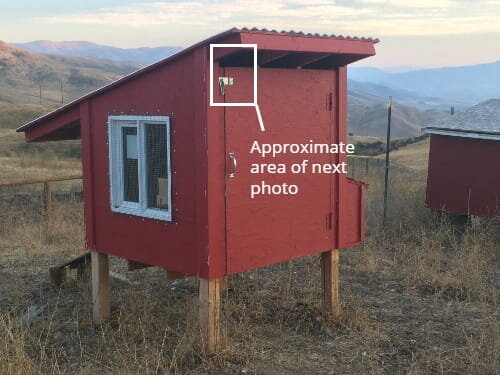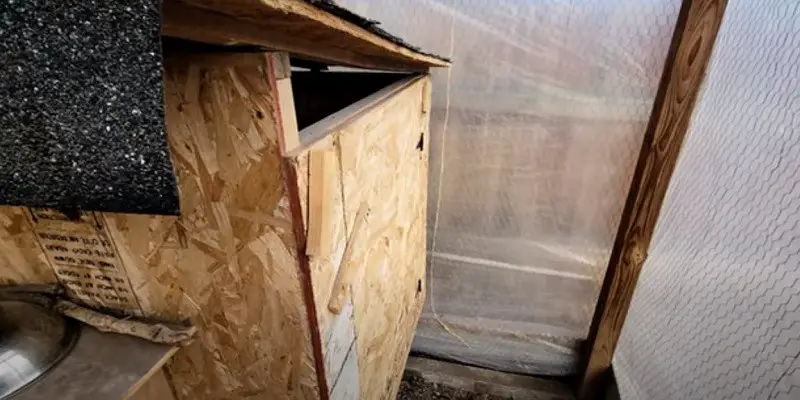Last Updated on April 23, 2025 by Pauline G. Carter
To ventilate a small chicken coop, install windows and vents for proper air circulation. Position them strategically for optimal airflow and comfort for the chickens.
Proper ventilation is crucial for a small chicken coop to maintain a healthy and comfortable environment for the birds. Inadequate ventilation can lead to a build-up of ammonia, excessive moisture, and heat stress, which can negatively impact the health and productivity of the chickens.
By strategically placing windows and vents, you can ensure proper air circulation and regulate the coop’s temperature. This also helps to eliminate odors and reduce the risk of respiratory issues in the chickens. We will explore different ventilation options and provide tips on how to effectively ventilate a small chicken coop to promote the overall well-being of the birds.

Credit: www.thefeatherbrain.com
Importance Of Ventilation
Ventilation is vital in maintaining a healthy environment for chickens in a coop. Proper airflow is essential for removing excess moisture, ammonia, dust, and carbon dioxide, while also replacing stale air with fresh, oxygen-rich air. Without adequate ventilation, chickens may suffer from respiratory problems and heat stress, which can impact their overall health and egg production.
Effects Of Poor Ventilation On Chicken Health
Poor ventilation in a chicken coop can lead to various detrimental effects on the health of the birds. Stagnant air increases the concentration of harmful gases and airborne contaminants, leading to respiratory issues such as coughing, sneezing, and eye irritation. Additionally, high humidity levels resulting from poor ventilation can cause feather pecking and increase the risk of mold and bacterial growth, which can lead to infections and diseases.
Role Of Ventilation In Temperature Regulation
Ventilation plays a crucial role in regulating the temperature inside a chicken coop. During hot weather, proper airflow helps to dissipate accumulated heat, preventing heat stress in chickens. Conversely, in cold weather, ventilation aids in maintaining a comfortable temperature by removing excess moisture and preventing condensation, which can contribute to drafts and frostbite. Effective ventilation ensures a consistent and comfortable environment for the birds throughout the year.
Assessing Ventilation Needs
When it comes to successfully managing a small chicken coop, ensuring proper ventilation is crucial. This not only helps to maintain favorable air quality but also regulates temperature and humidity levels, ultimately contributing to the overall health and well-being of the chickens. Before implementing ventilation solutions, it’s essential to assess the specific needs of your chicken coop.
Determining Coop Size And Layout
Firstly, consider the size and layout of the coop. The dimensions and structure of the coop will directly influence the airflow and ventilation requirements. Assess the square footage and the number of chickens housed in the coop to determine the adequate ventilation needed. A general rule of thumb is to allow for at least 1 square foot of ventilation per 10 square feet of floor space.
Identifying Ventilation Requirements Based On Climate
Climate plays a significant role in identifying ventilation needs for a small chicken coop. Whether you are dealing with hot, humid summers or chilly winters, understanding the specific weather conditions in your area is essential. Warmer climates may require more extensive ventilation to prevent heat build-up, while colder climates may necessitate reduced but strategically placed openings to avoid drafts. Assessing the specific climate conditions will help in tailoring the ventilation system to best suit the needs of your chickens.
Ventilation Solutions
Ventilation is a crucial aspect of maintaining a healthy environment for your chickens in a small coop. Adequate ventilation helps in regulating temperature, reducing humidity, and removing harmful gases and odors. Proper ventilation solutions are essential for the overall well-being and productivity of your poultry. Implementing natural and mechanical ventilation options can ensure a comfortable and safe living space for your feathered friends. Let’s explore some effective ventilation solutions for small chicken coops.
Natural Ventilation Options
Creating a well-ventilated environment using natural methods is cost-effective and sustainable. It involves strategizing the placement of windows, vents, doors, and openings to facilitate a continuous flow of fresh air.
Windows And Vents Placement
Strategically positioning windows and vents allows for the entry of fresh air while promoting air circulation. Placing vents higher up on the walls and windows opposite the prevailing wind direction encourages cross-ventilation, ensuring a constant supply of fresh air without creating drafts.
Proper Use Of Doors And Openings
Utilize doors and openings to regulate airflow based on the prevailing weather conditions. During hot weather, adjust doors and openings to allow hot air to escape, while in colder conditions, controlling ventilation to prevent drafts and heat loss is crucial. Being mindful of the balance between airflow and temperature is key to optimizing natural ventilation.
Mechanical Ventilation Options
In addition to natural ventilation, mechanical solutions can further enhance the airflow within a small chicken coop. These options involve the use of fans and air circulation systems to ensure consistent air quality and temperature control.
Fans And Air Circulation Systems
Installing fans can be an effective way to improve air movement within the coop. Fans can help in distributing fresh air, reducing humidity, and eliminating stagnant air pockets. Employing air circulation systems, such as exhaust fans and intake vents, can contribute to maintaining a well-ventilated environment, especially during periods of extreme weather.
Maintaining Proper Ventilation
Proper ventilation in a small chicken coop is crucial for the well-being of your poultry. To ensure adequate air circulation, consider installing windows or vents to let fresh air in and remove stale air. This helps prevent the buildup of harmful gases and maintains a healthy environment for your flock.
Regular Cleaning And Inspection
Regular cleaning and inspection of the chicken coop are essential for maintaining proper ventilation. Remove accumulated droppings, feathers, and dirt from the coop to prevent blockage of vents. Clean the coop interior and nesting areas to prevent the buildup of ammonia and other harmful gases. Inspect the vents, windows, and doors to ensure they are functioning properly and clear of any obstructions.
Seasonal Adjustments For Optimal Airflow
Seasonal changes affect the airflow within the chicken coop. During warmer months, proper ventilation is crucial to prevent overheating. Adjust the vents to maximize airflow and consider adding additional vents if necessary. In colder months, a balance between ventilation and insulation is essential to maintain a comfortable environment for the chickens. Ensure that vents are open enough to provide fresh air without causing drafts that can affect the coop’s temperature.
Frequently Asked Questions On How To Ventilate A Small Chicken Coop?
Why Is Ventilation Important For A Chicken Coop?
Ventilation is crucial to prevent heat and moisture buildup, keeping chickens healthy and comfortable.
What Are The Signs Of Poor Ventilation In A Chicken Coop?
Indications of poor ventilation include foul odors, condensation, and an increase in respiratory issues among the chickens.
How Can I Improve Ventilation In A Small Chicken Coop?
Install windows, vents, and fans to enhance air circulation and expel stale air, ensuring a healthier coop environment.
What Measures Can Be Taken To Regulate Coop Temperature Through Ventilation?
Adjust ventilation openings seasonally to maintain optimal temperatures, promoting chicken well-being in varying weather conditions.
How Can I Prevent Drafts While Ventilating A Small Chicken Coop?
Strategically position ventilation openings to prevent direct drafts on the chickens, ensuring proper air movement without discomfort.
What Are The Best Practices For Seasonal Ventilation Adjustments In A Chicken Coop?
Utilize adjustable vents and windows to regulate airflow, accommodating for seasonal temperature and humidity changes effectively.
Conclusion
Small chicken coops require proper ventilation for the health and well-being of the birds. Good airflow prevents moisture and ammonia buildup while maintaining optimal temperature. By implementing the suggested ventilation strategies, you can promote a safe and comfortable environment for your chickens, ensuring their overall welfare and productivity.

